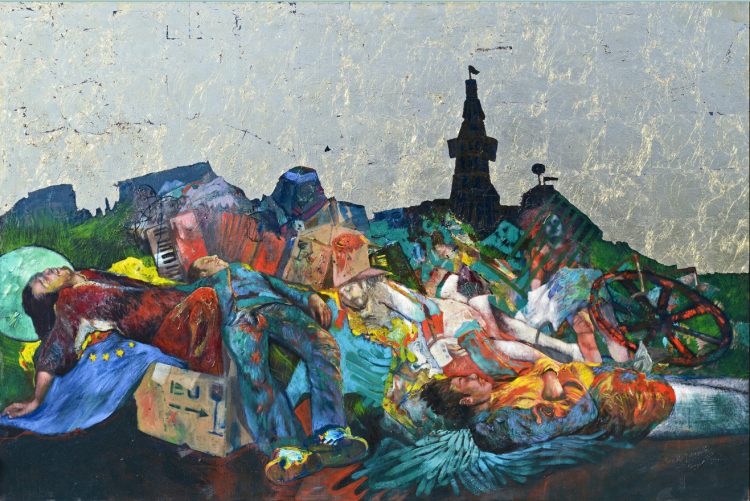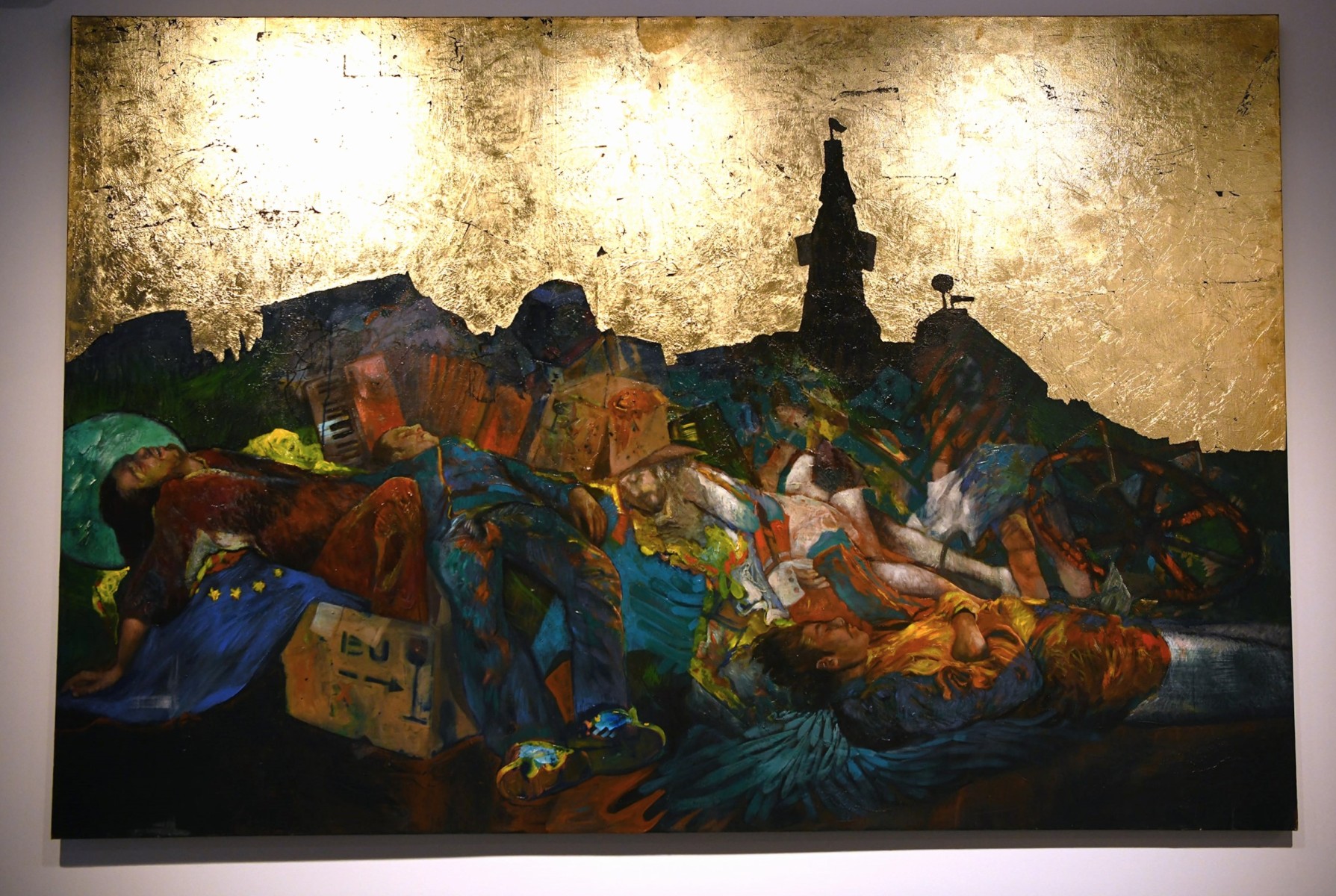The Red Wheel of Pain and Power – On Zoran Tairović’s Works

The exhibition currently on view at the European Roma Institute for Arts and Culture (ERIAC) Serbia, in Belgrade, titled “Gypsyism, Balkanism – Through a glass, darkly”, curated by Bratislav Mitrović, features five artists of Roma origin, who engage in intimate dialogue with the history of -frequently hurtful- representations of Roma.
Through their works, Małgorzata Mirga-Tas (Poland), Ľuboš Kotlár (Slovakia), Vera Lacková (Slovakia/Czech Republic), Mara Oláh Omara (Hungary) (1945-2020), and Zoran Tairović (Serbia) offer, in Mitrović’s words, “a new image of Roma” through which the equation becomes more apparent, where both Roma and the Balkans are the “Others” in Europe.
In this overview, we will focus on the works of Zoran Tairović, represented in the exhibition by two paintings. The composition Twilight or Dawn of Europe (2012-2021 | acrylic, oil on canvas | 160 x 240 cm) has been exhibited at the artist’s solo exhibitions, including those in Prague and Belgrade. Describing the painting, which, in the space of the ubiquitous Vašarište, symbolizes a kind of hell of earthly life and a world in the clutches of political rulers, the author himself says: “I used the painting process to translate my experiment on the topic of social statuses and political views attributed to the expressions of ‘homeless Roma’ into a painting drama full of audacity, unbridled mockery of traditional and indisputable moral and aesthetic norms. (…)” – and explains: “Using Shakespearean elements to construct the plot, instead of presenting man as a general concept, I built depersonalized characters, intentionally hyperbolized. Drawing from my own experience, they have externalized the status of the AGITATOR… Who defines their procedures? The answer is very simple. Life itself. The life that surpasses the concept of dignity and spills into a sea of suffering, sorrow, and humiliation… Thus, they become an allegory of agitators of 3.6 billion people plunged into a disenfranchised class.”
Zoran Tairović, Twilight or Dawn of Europe, 2012-2021. Acrylic, oil on canvas, 160x240 cm.
Tarot Hybrid Image: Twilight or Dawn of Europe. The Tower, the sixteenth card, the Wheel of Fortune, the tenth card, with an octagonal wheel, among other elements, a symbol of eternity in Hindu and Buddhist religious traditions, signifies an iconographic crescendo in relation to the hermetic symbols of the original template. Reinterpreting the method of Géricault’s “The Raft of the Medusa” in a different context, in his work, Tairović supports the idea of the cyclical nature of time and, of course, fate. Evil or suffering as a consequence of evil, is clearly contextualized and visible here. The pseudo-baroque tower against the golden background of the painting, the sails, lifeless bodies, and cardboard in the foreground, accordion, provide clear thematic guidelines for the semantic layer of the work. The red wheel, a central symbol of Roma philosophy of life that sees movement as a true support, is a powerful metaphor.
On the whole, this cycle brings to the fore the questions of sin, guilt, anxiety, authority, and wisdom… it points to the intricate paths of ideologies and existence, while the presence of symbols establishes connections of meaning, often with painful connotations.
Gypsyism, Balkanism - Through a glass, darkly; exhibition opening, 2023, ERIAC Serbia
The old theme—Noah’s Ark—is more relevant than ever. A sensitive painter, he responds to the earthquakes in Turkey, the war in Ukraine, the situation in Kosovo, and finally, to the conflict between Israel and Hamas, with a riot of colors and shapes. Hence, the currently exhibited diptych Syria (2023 | acrylic, oil on canvas | 100 x 200 cm), is just one of the variations of the composition with the same name. Fierce colors, restless forms, and narrative draped in symbolism bear witness to the author’s deep experience of tragedies that we cannot perceive as isolated or something that happens to others. The interplay of colors in this painting, reminiscent of El Greco, evokes pain, helplessness, and the disappearance of innocent beings, visualizing the extinction of life and culture.
*
Zoran Tairović is an academic painter and interdisciplinary artist. He has dedicated himself to the Roma theme from his early paintings through numerous projects to the present day. His early efforts include the establishment of the Intercultural Theater based on the ideas of Peter Brook, through which he chose to work with marginalized groups. He is the author of the first Roma musical, which premiered at the theater festival in Edinburgh in 2008. In this stage work, performers sing and speak in seven languages, including Romani. Tairović’s lavish talent is also reflected in the Roma opera “Invisible Gypsy,” with a libretto addressing legally invisible people. This work premiered in Prague in 2009 and, a few years later, in the Belgrade Drama Theatre. Another notable work is the Mandala, a cake of human rights (870 kg), the central artifact of a performance in Prague in 2015, with numerous participants, aimed at addressing the issue of Roma and human rights. Another playful yet serious endeavor by Tairović is the establishment of the State of Art in Mali Iđoš in 2016 (stateofart.info), an elaborate platform for the exchange of experiences in artistic spheres and the promotion and popularization of creativity. In the same year, at that location, he initiated the festival of short-film with a Roma theme “FROM,” which takes place every summer with great success, promoting the knowledge and awareness of Roma life. Simultaneously, it serves as a venue for music concerts, theatrical performances, and an exhibition platform for the artist’s recent metal sculptures.
As a painter Tairović has been practically engaged in the same topic for decades, which is also supported by personal theoretical work – the transmission of information based on symbolic images. On his canvases, the painter puts forward his fundamental premise, namely that there is an invisible art of the Roma, an integral part of European modern culture and art, which could serve as a catalyst for redefining the history of art and other phenomena in the cultural life of Europe, embedded within the frameworks of national art histories.
The postmodernist period marks his formation as an artist, hence the focus on some values known in the history of art. However, it is not about copying but subliming inherited models through the crucial prism of the creator, the artist, and less crucially, the Roma. In this context, the Roma identity is not a prerequisite or consequence; it is as firm and certain as it is fragile since the artist, unlike many others, understands to what extent ephemeral and non-existent abounds in the perception of those seeking everything for themselves, and that the fate of the invisible is today shared by others. By his own example, Tairović indicates how much can truly be gained through the most dedicated work conceivable. His erudition and skills allow him to own hybrid art, a stylistic blend of languages and paradigms while leaving at the same time a trace of authenticity.
*
It is considered that Serbs and Roma, in our region, have been sharing a destiny for at least seven centuries. Do we pay enough attention to Roma, do we know anything about their art? What is Romani art? The art performed by members of this people? There are several reasons why this question suddenly stands out as if we are not talking about national art schools and periods in Italian, French, German, and Serbian art… To start with, these are nomadic people, but assimilation, throughout history, as well as to historiographical methods, divisions, and hierarchical ones, contributed to their invisibility, compounded by the very nature of the Roma people. On the other hand, even when some progress is made to affirm Romani creativity, it is usually short-lived, intended to serve daily political needs and purposes, including profiteering.
Some of the landmark Yugoslav and Serbian cinematographic achievements have explored Romani themes. The exceptional success of these works at international film events, which by their nature attract huge audiences, is somewhat attributed to a one-sided description of Romani culture, while stereotypes should be left in the past. Some film directors have engaged Romani actors, and Tairović regularly does so, for example, in the feature film “And There Was the King,” in which two main roles are played by Romani people, legally invisible homeless individuals, participants in the wars of the 1990s.
Romani culture has always inspired artists, especially in this region. Physiognomic characteristics, enhanced by exposure to elements, picturesque clothing ensembles, the beauty of youth, group compositions in motion with a horse, sometimes a dog—these have all been attractive subjects for famous and less famous painters of the previous century. However, what can be said about Romani visual artists in Serbia?
While Romani music is no doubt well-known and appreciated, similar examples are lacking in other arts. Romani literature is insufficiently known here. Several researchers, including Rajko Đurić, have documented stories and legends from this oral tradition, but discussion on broader public reception still lacking. Therefore, the example of the young author Meti Kamberi, the writer of the book “Goli život” (Naked Life), is encouraging, as it turns the discourse on Roma in a positive direction. Since 2009, Belgrade also has the Museum of Romani Culture, the first institution of its kind in Southeastern Europe. It preserves, among other things, the world’s first text in the Romani language from 1537, published in England, as well as the Serbian-Romani-German dictionary by Svetozar Simić, compiled in 1942 in a German concentration camp. Still, the Romani Sanctuary in Belgrade is unfortunately being obliterated.
As far as the art of painting is concerned, in central Serbia, in Trstenik, Miloš Vasić, organizer and painter, manages the Roma Center, a hub for nurturing and promoting Romani painting production, indisputably dominated by the works of Zoran Tairović. Beyond the country’s borders, there are also notable names, like Dušan Jovanović, a hyper-realistic artist, living and working in Rimini, Italy. Even though this is just a handful of harbinger artists, but the wheel has been set in motion. Once empowered, this artistic drive is bound to pave the way for new notable names even outside the context of Romani art.
This text is co-financed by the Governments of Czechia, Hungary, Poland and Slovakia through Visegrad Grants from the International Visegrad Fund. The mission of the fund is to advance ideas for sustainable regional cooperation in Central Europe.





Leave a Reply